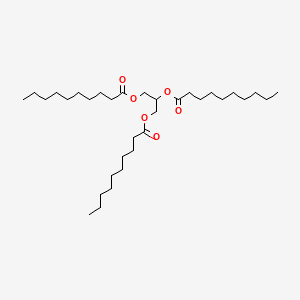| Authors | Title | Published | Journal | PubMed Link |
|---|---|---|---|---|
| Nii T and Ishii F | Dialkylphosphatidylcholine and egg yolk lecithin for emulsification of various triglycerides. | 2005 | Colloids Surf B Biointerfaces | pmid:15748826 |
| Tsuzuki W et al. | Inhibitory effect of lysophosphatidylcholine on pancreatic lipase-mediated hydrolysis in lipid emulsion. | 2004 | Biochim. Biophys. Acta | pmid:15450204 |
| Lim SJ and Kim CK | Formulation parameters determining the physicochemical characteristics of solid lipid nanoparticles loaded with all-trans retinoic acid. | 2002 | Int J Pharm | pmid:12176302 |
| Schaefer MJ and Singh J | Effect of tricaprin on the physical characteristics and in vitro release of etoposide from PLGA microspheres. | 2002 | Biomaterials | pmid:12099290 |
| Langone MA and Sant'Anna GL | Process development for production of medium chain triglycerides using immobilized lipase in a solvent-free system. | 2002 | Appl. Biochem. Biotechnol. | pmid:12018320 |
| Wanten GJ et al. | Saturated triglycerides and fatty acids activate neutrophils depending on carbon chain-length. | 2002 | Eur. J. Clin. Invest. | pmid:11952815 |
| Kang F and Singh J | Effect of additives on the release of a model protein from PLGA microspheres. | 2001 | AAPS PharmSciTech | pmid:14727867 |
| Schaefer MJ and Singh J | Effect of additives on stability of etoposide in PLGA microspheres. | 2001 | Drug Dev Ind Pharm | pmid:11411902 |
| Fontagné S et al. | Tricaproin, tricaprin and trilaurin are utilized more efficiently than tricaprylin by carp (Cyprinus carpio L.) larvae. | 2000 | J. Nutr. | pmid:10917917 |
| Horowitz JF et al. | Preexercise medium-chain triglyceride ingestion does not alter muscle glycogen use during exercise. | 2000 | J. Appl. Physiol. | pmid:10642384 |
Tricaprin
Tricaprin is a lipid of Glycerolipids (GL) class. The associated genes with Tricaprin are RHOQ gene. The related lipids are tricaproin and trilaurin.
Cross Reference
Introduction
To understand associated biological information of Tricaprin, we collected biological information of abnormalities, associated pathways, cellular/molecular locations, biological functions, related genes/proteins, lipids and common seen animal/experimental models with organized paragraphs from literatures.
What diseases are associated with Tricaprin?
There are no associated biomedical information in the current reference collection.
No disease MeSH terms mapped to the current reference collection.
PubChem Associated disorders and diseases
What pathways are associated with Tricaprin
There are no associated biomedical information in the current reference collection.
PubChem Biomolecular Interactions and Pathways
Link to PubChem Biomolecular Interactions and PathwaysWhat cellular locations are associated with Tricaprin?
There are no associated biomedical information in the current reference collection.
What functions are associated with Tricaprin?
There are no associated biomedical information in the current reference collection.
What lipids are associated with Tricaprin?
Related references are published most in these journals:
| Lipid concept | Cross reference | Weighted score | Related literatures |
|---|
What genes are associated with Tricaprin?
Related references are published most in these journals:
| Gene | Cross reference | Weighted score | Related literatures |
|---|
What common seen animal models are associated with Tricaprin?
There are no associated biomedical information in the current reference collection.
